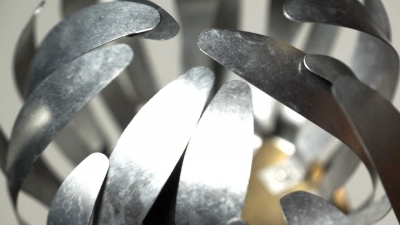
When lightning struck the roof of York Minster, one of Britain’s finest medieval cathedrals, in 1984, it started a fire that was if trapped between the ceiling and the wooden roof. Firefighters could not get into the area, and the enormous heat that built up destroyed most of the roof.
If lightning should strike York Minster twice, space-age science has ensured that the same type of damage will not happen again. The new roof is fitted with trap doors to let the heat out and the firefighters in, and the doors have latches operated by springs made from memory metals, which will open automatically if they get hot.
Memory metals have two different shapes they can ‘remember’, and will switch from one to the other under certain conditions. The York Minster trap-door springs are made to remember a certain temperature, at which they will expand and withdraw the bolt, releasing the door.
One of the first uses of memory metals has been for hydraulic pipe couplings in aircraft, which came into use in 1971. The couplings are made too small to fit at a certain temperature, and are then cooled to well below room temperature and stretched to fit. When they warm up to their normal operating temperature, they shrink to the first shape, forming a tight joint. The same idea is used in surgery, with metal couplings to bind together broken bones. Body heat keeps them constantly tight.
Metals that change their shape under heat now have all kinds of uses, such as operating switches and valves in automatic coffee machines, and opening greenhouse windows when it is hot and closing them when it is cold. Most metals are made up of crystals (arrangements of atoms). When two or more metals are combined into an alloy, the alloy can form different crystal structures under different conditions.
Some alloys, if they are cooled rapidly, will undergo an abrupt change to a different alignment of crystals at a certain temperature. This transition temperature varies with the make-up of the alloy. The changed structure it brings about is called martensite, after the German metallurgist Adolph Martens who first identified it.
If such an alloy is shaped by heat treatment so that it becomes martensite at, for example, 122°F (50°C), it will change its shape at that martensitic temperature, but revert again at a different temperature.
Shaped for shaping
A Japanese company has found an unusual use for memory metals — as a super-elastic wire frame in brassieres. The alloys used will stretch up to ten times more than ordinary metals. When stretched in use, the bra wire gradually returns to its original bust-supporting shape.
Another use for super-elastic wire is in straightening teeth. Conventional stain-less-steel wires have to be regularly tightened, often by turning a tiny key. Super-elastic alloy wires exert a continuous gentle pressure ideal for coaxing teeth in the right direction.
Picture Credit : Google

